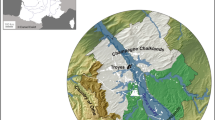Abstract
This contribution summarizes archaeobotanical analyses dealing with the identification of practices such as cultivation of morphologically wild or weedy plants, as opposed to the gathering and cultivation of morphologically domestic plants, in northwestern Argentina. The presence of “intermediate” forms of Cucurbita maxima (squash) and Phaseolus vulgaris (common bean) together with their wild and domestic counterparts in the same archaeological contexts suggests the presence of wild/weedy/domestic crop complexes in the past. Practices which lead to these kinds of complexes (allowing the presence of wild relatives and interbreeding) seems to represent a long term modality of people-plant interaction in northwest Argentina detected in archaeological sites of different ages, spanning from 2,000 bp until modern local communities. This evidence, together with other morpho-anatomical traits of macro remains showing low standardization in size and shape (highly diverse biometric and qualitative features), points to a low incidence of selective pressures in crop populations throughout cultural development of the area. This argues for a horticultural system as opposed to large scale agriculture, entailing “mutual nurturing” which for this region demonstrates an alternative to the classic model of domestication.



Similar content being viewed by others
References
Arreguez G, Martínez J, Oliszewski N, Ponessa G Problemas relacionados a la recuperación e identificación de macrorrestos vegetales en sitios arqueológicos del Holoceno medio y tardío en el Noroeste argentino: el caso del amaranto y la quínoa. In: Belmar C, Lema V (eds) Avances y desafíos metodológicos en arqueobotánica: miradas consensuadas y diálogos compartidos desde Sudamérica. SEK University, Santiago. (in press)
Aschero C, Hocsman S (2011) Arqueología de las ocupaciones cazadoras-recolectoras de fines del Holoceno medio de Antofagasta de la sierra (puna meridional argentina). Chungara 43:393–411
Babot MP (2011) Cazadores-recolectores de los Andes centro-sur y procesamiento vegetal. una discusión desde la puna meridional argentina (ca. 7.000-3.200 AÑOS a.p.). Chungara 43:413–432
Babot MP, Hocsman S, Piccón Figueroa R, Haros C (2012) Recetarios prehispánicos y tradiciones culinarias. casos de la puna argentina. In: Babot MP, Marschoff M, Pazzarelli F (eds) Las manos en la masa. Arqueologías, antropologías e historias de la alimentación en Suramérica. Universidad Nacional de Córdoba, Museo de Antropología UNC—Instituto Superior de Estudios Sociales UNT, Córdoba, pp 235–270
Beebe S, Toro Ch, González A, Chacón M, Debouck C (1997) Wild-weedy-crop complexes of common bean (Phaseolus vulgaris L. Fabaceae) in the Andes of Peru and Colombia, and their implications for conservation and breeding. Genet Resour Crop Evol 44:73–91
Cowan CW, Smith BD (1993) New perspectives on a wild gourd in Eastern North America. J Ethnobiol 13:17–54
Grillo Fernández E, Quiso Choque V, Rengifo Vásquez G, Valladolid Rivera J (1994) Crianza andina de la chacra. PRATEC, Lima
Korstanje A, Quesada M, Franco Salvi V, Lema V, Maloverti M Gente, tierra, agua y cultivos: los primeros paisajes agrarios del hoy Noroeste argentino. In: Korstanje A, Lazzari M (eds) Crónicas materiales precolombinas. Arqueología de los primeros poblados del Noroeste Argentino. Tucumán University, Tucumán. (in press)
Lema V (2009) Domesticación vegetal y grados de dependencia ser humano—planta en el desarrollo cultural prehispánico del Noroeste argentino. Unpubl PhD thesis, Universidad Nacional de La Plata
Lema V (2011) The possible influence of post-harvest objectives on Cucurbita maxima subspecies maxima and subspecies andreana evolution under cultivation at the Argentinean Northwest: an archaeological example. Archaeol Anthropol Sci 3:113–139
Lema V (2012) Nuevas ideas sobre la domesticación ¿nuevas ideas sobre el Formativo? aportes para una relectura crítica. Dissertation Taller Arqueología del periodo Formativo en Argentina: un encuentro para integrar áreas y sub-disciplinas, revisar significados y potenciar el impacto de las investigaciones en curso, Tafí del Valle, Tucumán
Lema V (2013) Crianza mutua: una gramática de la sociabilidad andina. Proceedings of the X. Reunión de Antropología del Mercosur, CD-Rom
Lema V, Capparelli A, Pochettino ML (2008) Taxonomic identification of Cucurbita species through seed coat micromorphology: implications for dry and carbonized archaeobotanical remains. Veget Hist Archaeobot 17(Suppl 1):S277–S286
Menéndez Sevillano MC (2002) Estudio y conservación del germoplasma silvestre y primitivo de Phaseolus vulgaris L. en el Noroeste argentino. Unpubl. PhD thesis, Universidad de Santiago de Compostela
Oliszewski N, Babot MP (2013) Procesos de selección del poroto común en los valles altos del noroeste argentino en tiempos prehispánicos. Análisis micro y macroscópico de especimenes arqueobotánicos. In: Belmar C, Lema V (eds) Avances y desafíos metodológicos en arqueobotánica: miradas consensuadas y diálogos compartidos desde Sudamérica. SEK University, Santiago. (in press)
Piperno D, Pearsall D (1998) The origins of agriculture in lowland tropics. Academic Press, San Diego
Author information
Authors and Affiliations
Corresponding author
Additional information
Communicated by S. M. Valamoti.
Rights and permissions
About this article
Cite this article
Lema, V.S. Non-domesticated cultivation in the Andes: plant management and nurturing in the Argentine northwest. Veget Hist Archaeobot 24, 143–150 (2015). https://doi.org/10.1007/s00334-014-0494-7
Received:
Accepted:
Published:
Issue Date:
DOI: https://doi.org/10.1007/s00334-014-0494-7




